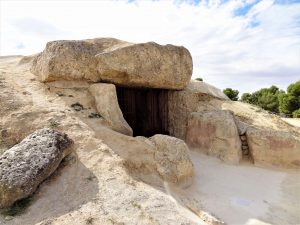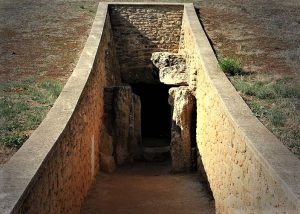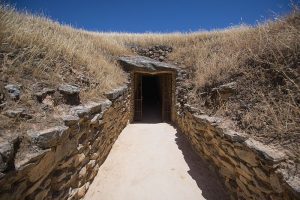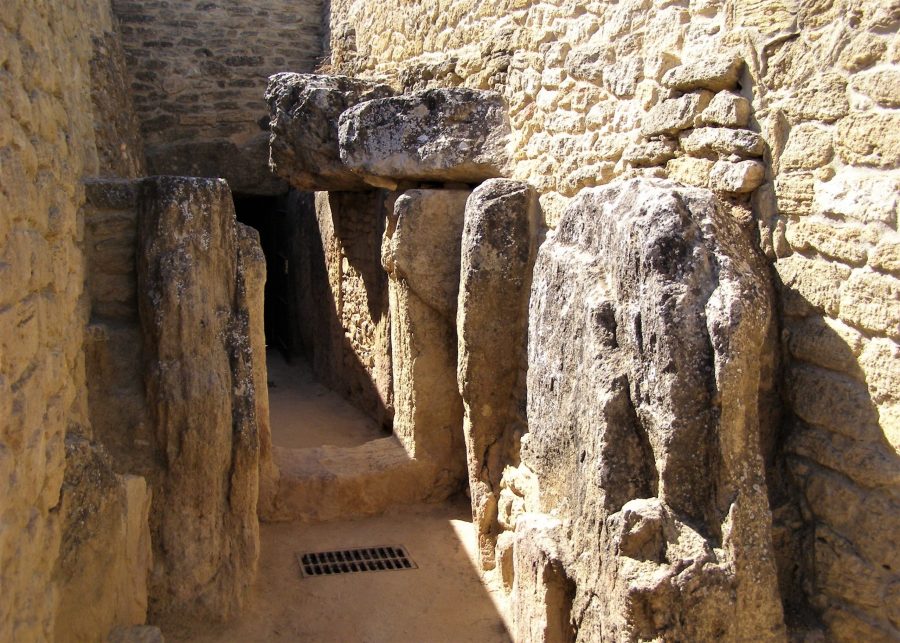In southern Spain Antequera, the best-preserved remains of the Bronze Age can be seen in all of Europe. The dolmens of Antequera, Menga, Viera and El Romeral are megalithic constructions that are more than four thousand years old.
The site is on UNESCO’s World Heritage List. Dolmens are prehistoric funerary monuments made of large vertical boulders topped with other large stones that act as a roof. Originally, “dolmen” is Breton for table. Despite their long existence, the dolmens in Antequera have remained largely intact. Because of this we can still admire them and marvel at gigantic boulders with which our distant ancestors, aided only by muscle, livestock, wooden planks and logs, built collective graves for the better off. On the plain of Antequera, these dolmens are evidence of the existence of a prehistoric civilization. A few refer to the dolmen of Menga as the Sistine Chapel of antiquity.
Stonehenge dolmens
In Europe several versions of this type of collective graves can be found, such as Stonehenge in England. These indicate a socially stratified society, in which the chiefs and their families were given more luxurious cemeteries than others. To date, no human remains have been found in the dolmens of Antequera, but it is believed that they were once robbed or have now completely decayed.
The Menga dolmen has been famous since the second half of the 17th century. In 1847, Málaga municipal architect Rafael Mitjana published a short study on the then famous “Cueva de Menga” (cave of Menga). He qualified the temple as Celtic. It is now clear that he was mistaken. After this dolmen had disappeared from view again, the Viera brothers discovered in 1903 the first dolmen near their farm. It was named after them. Two years later they discovered the dolmen of Menga. It wasn’t until 1905 that the other dolmens were discovered. The first restoration work started in 1941
Dólmen de Menga
The Menga dolmen is the oldest of the three and dates back to the beginning of the Bronze Age (around 2,500 BC). A small hill houses a large, monumental and oval-shaped burial chamber. From the entrance, the dolmen looks like a long-covered gallery. The burial chamber is formed by seven large square blocks of stone that are covered by a massive 180,000 kilograms (42 square meters!) rock. It is inconceivable that without technical aids people would have been able to move this gigantic piece of limestone, let alone lay it across the other blocks. To support the roof bricks, there are three large pillars in the square part at the back.

dolmen de menga
The dolmen of Menga is the only one where inscriptions have been found. On the first stone to the left behind the entrance gate are some anthropomorphic figures. You can also clearly recognize a fossil of a starfish in between. It seems to have gotten lost, but two hundred million years ago the south of Spain was still under water. It was not until 20,000 years ago that a collision of tectonic plates raised the bottom.
Dólmen de Viera
The dolmen of Viera is, according to current information, about 4000 years old. This dolmen has a long, narrow corridor that leads to the square burial chamber at the very end. A square opening cut from a large rock serves as an entrance. The hallway is completely original, unlike the ‘roof’. Here only four of the seven pieces of stone that were originally there have been preserved. There are large, round holes in these stones. Each measuring exactly five centimetres in diameter and ten centimetres deep. It is very likely that these must have existed all along, but ‘why’ is something researchers still don´t know.

dolmen de viera
Dólmen Romeral
One kilometre away, the Romeral dolmen represents a much more modern construction dating back to the end of the Bronze Age (around 1800 BC). This is a dolmen of the ‘tholos’ type, which means dome. A long, narrow corridor leads to two round burial chambers, one behind the other, separated by a narrow corridor. The walls are made of small stones and the burial chambers are both covered with a huge flat stone. The front burial chamber is almost twice the size of the rear.

In the second burial chamber, a huge stone in the shape of a pillar appears to hang eight inches above the floor, because it is mounted horizontally in the wall. Part of the original altar was found here. Around it were objects that must have been part of a stakeout. These dolmens were also discovered by the Viera brothers (in 1905), who gave the building the name of a country house near the site.
Read more about the theories about the construction of the Dolmens of Antequera, about the location of these megalithic constructions and their inhabitants.
Other things to do in this area: Visit the largest nativity scene in the world in the province of Málaga


